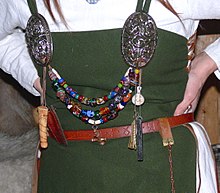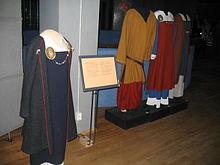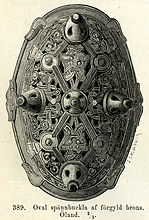User:Berig/workshop




Tortoise brooches or oval brooches are ubiquitous[1] brooches that were characteristic of the early Viking Age woman and "indicate beyond doubt" her Norse identity in grave finds.[2] The tortoise brooches went out of fashion in the mid-tenth century.[3]
Archaeology[edit]
They are the most characteristic finds of jewellery and they were usually of bronze, and they are especially found in graves from the 9th c. and the first half of the 10th c. To archaeologists they not only serve to indicate that it was a Norse woman's burial, but they also help in reconstructing her dress, as textiles don't preserve well, but fragments are often found near the brooch, and sometimes the textiles have left impresions on the brooches. Judith Jesch comments that were it not for them, very little would be known of how well-dressed Norse women looked in the Viking Age. In fact, meticulous studies done by scholars such as Agnes Geijer and Inga Hägg in Birka have enabled them to reconstruct the entire female dress, in spite of the fact that no complete female habit has been preserved. Finds in other places, such as Hedeby confirm that women dressed very much the same across the Norse world, wherever Viking Age Scandinavians lived and settled.[4]
The dress and practical use[edit]
They were not only decorative, but they also served to keep the dress up. Usually, women wore an underdress, a shift. It may have been made of linen or wool, it had sleaves, and could be pleated and it was gathered near the neck. The opening for the neck was generally fastened with a small disk brooch. Over this, she wore an overdress, a strapped gown. It was usually a rectangular woolen piece that was wrapped around her up to her armpits. This gown was held up by two straps that were fastened at her back and went over her shoulders and were attached to two loops in the front with the two tortoise brooches.[4] Consequently, it may be more appropriate to call them buckles. Useful tools, such as knives and scissors could hang from the brooches attached with rings or straps. In many female graves, hanging between the brooches, there had been strings with beads and among the beads there could be pendants of silver, amber and jet, such as a cross when a woman had converted to Christianity.[5]
A third piece of clothing was a tunic that could be worn between these garments. Such clothing has been found in Birka and is a clear case of influence from the Middle East. Well-dressed women would have those tunics decorated with braids of tablet-woven silk and linen, and often with a weft of metal to give an impression of luxury. When she was outdoors she wore over all these a cloak or a caftan with sleaves, and this garment was fastened in the front with a pin or a brooch. This brooch was more variable and could be in the form of a trefoil, a disc, and equal armed brooch or a reworked souvenir her husband had brought home to her.[5]
Eye witness[edit]
Jesch notes that in Ahmad ibn Fadlan's account of an encounter with Vikings on the Volga, we read about ornaments that are typical of those found in graves from Norse women all across the Viking world, and he also comments on "breast boxes" that probably are tortoise brooches[6]:
- Each woman wears on either breast a box of iron, silver, copper, or gold; the value of the box indicates the wealth of her husband. Each box has a ring from which depends a knife. The women wear neck rings of gold and silver, one for each of the 10,000 dirhems which her husband is worth; some women have many. Their most prized ornamens are green glass beads of clay, which are found on their ships. They trade beads among themselves and pay a dirhem for a bead. They string them as necklaces for their women.[6]
Gallery[edit]
-
Woodcut showing a tortoise brooch of guilded bronze Öland.
Notes[edit]
- ^ Jesch 1991, p. 18.
- ^ Jesch 1991, p. 9.
- ^ Jesch 1991, p. 37.
- ^ a b Jesch 1991, p. 15.
- ^ a b Jesch 1991, p. 16.
- ^ a b Jesch 1991, p. 120.
Bibliography[edit]
- Jesch, Judith (1991). Women in the Viking Age. Boydell & Brewer Ltd. ISBN 978-0-85115-360-5.









